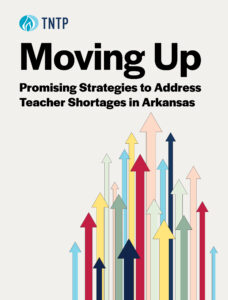Last week, we were proud to release A Strong Foundation: Three State Policy Priorities to Give Every Student Effective, Diverse Teachers, an issue brief intended to help state-level leaders and advocacy organizations build or strengthen their teacher policy agenda. In it, we recommend steps that all states can take to strengthen their teacher pipelines, help ensure more effective new teachers, and diversify their teacher workforce.
To identify priorities and example policies, we looked for publicly-available data on teacher preparation and the teacher workforce in all 50 states, and completed an extensive literature review. But we also took a closer look at eight data-rich states to get a more complete picture of the way policies may be interacting, and to better understand the challenges each state is currently facing. We chose a diverse set of states in the hopes that our findings would be applicable nationwide.
We published our findings for each of those states (Arkansas, California, Delaware, Illinois, Louisiana, Massachusetts, Tennessee, Texas) as a set of profiles—you can access them here—and wanted to share a bit more about them in case you missed them in the original release.
Our goal with the profiles was to build a more complete picture of the teacher policy landscape in each state. We included data and trends alongside the policies themselves in order to highlight the interdependent nature of policy, context, and circumstances. In each profile, you’ll find information from the National Center for Education Statistics, links to teacher workforce and preparation reports, and summaries of state-specific programs and statutes. The profiles are organized into five sections:
- State Overview: High-level data on the state and its student population.
- Teacher Workforce: Data on teacher preparation program completers, as well as state requirements for data reporting on the state’s teacher workforce and preparation, including vacancies.
- Teacher Preparation Programs: State practices for recruiting teachers, certification requirements, and other requirements and guidelines for teacher preparation programs.
- Policy Landscape: Information on the governance of the state education system, as well as relevant recent policy changes.
- Trends: Demographic trends, teacher shortages, and other current focuses and challenges.
How can these be helpful? If you live or work in one of the eight profiled states, they provide useful information on local teacher workforce successes and challenges, and where things may be headed. This information can start conversations about what is and isn’t working, help you answer the questions in our issue brief, and ultimately guide your advocacy efforts. If you live in another state, there’s a good chance that at least one of the profiled states is facing some of the same challenges as your own. You could look through the profiles for states with a similar population, urbanization, or demographic makeup as yours, and use them to help surface questions about what your state is doing or might do differently.
Let us know if these profiles yield any important insights about current policies—or even better, policy changes—in your state, or if we can be helpful as you work to give every student effective, diverse teachers.








